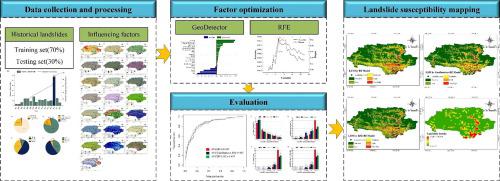Geoscience Frontiers ( IF 8.5 ) Pub Date : 2021-05-04 , DOI: 10.1016/j.gsf.2021.101211 Xinzhi Zhou , Haijia Wen , Yalan Zhang , Jiahui Xu , Wengang Zhang

|
The present study aims to develop two hybrid models to optimize the factors and enhance the predictive ability of the landslide susceptibility models. For this, a landslide inventory map was created with 406 historical landslides and 2030 non-landslide points, which was randomly divided into two datasets for model training (70%) and model testing (30%). 22 factors were initially selected to establish a landslide factor database. We applied the GeoDetector and recursive feature elimination method (RFE) to address factor optimization to reduce information redundancy and collinearity in the data. Thereafter, the frequency ratio method, multicollinearity test, and interactive detector were used to analyze and evaluate the optimized factors. Subsequently, the random forest (RF) model was used to create a landslide susceptibility map with original and optimized factors. The resultant hybrid models GeoDetector-RF and RFE-RF were evaluated and compared by the area under the receiver operating characteristic curve (AUC) and accuracy. The accuracy of the two hybrid models (0.868 for GeoDetector-RF and 0.869 for RFE-RF) were higher than that of the RF model (0.860), indicating that the hybrid models with factor optimization have high reliability and predictability. Both RFE-RF GeoDetector-RF had higher AUC values, respectively 0.863 and 0.860, than RF (0.853). These results confirm the ability of factor optimization methods to improve the performance of landslide susceptibility models.
中文翻译:

使用具有GeoDetector和RFE的混合随机森林进行滑坡敏感性地图以进行因子优化
本研究旨在开发两个混合模型,以优化因素并增强滑坡敏感性模型的预测能力。为此,创建了包含406个历史滑坡和2030个非滑坡点的滑坡清单图,将其随机分为两个数据集以进行模型训练(70%)和模型测试(30%)。最初选择了22个因子来建立滑坡因子数据库。我们将GeoDetector和递归特征消除方法(RFE)应用于地址因子优化,以减少数据中的信息冗余和共线性。此后,使用频率比法,多重共线性测试和交互式检测器来分析和评估优化因素。随后,随机森林(RF)模型用于创建具有原始因素和优化因素的滑坡敏感性图。对所得混合模型GeoDetector-RF和RFE-RF进行了评估,并通过接收器工作特性曲线(AUC)和精度下的面积进行了比较。两种混合模型的准确性(GeoDetector-RF为0.868,RFE-RF为0.869)均高于RF模型(0.860),表明具有因子优化的混合模型具有较高的可靠性和可预测性。RFE-RF GeoDetector-RF的AUC值均比RF(0.853)高,分别为0.863和0.860。这些结果证实了因子优化方法能够改善滑坡敏感性模型的性能。对所得混合模型GeoDetector-RF和RFE-RF进行了评估,并通过接收器工作特性曲线(AUC)和精度下的面积进行了比较。两种混合模型的准确性(GeoDetector-RF为0.868,RFE-RF为0.869)均高于RF模型(0.860),表明具有因子优化的混合模型具有较高的可靠性和可预测性。RFE-RF GeoDetector-RF的AUC值均比RF(0.853)高,分别为0.863和0.860。这些结果证实了因子优化方法能够改善滑坡敏感性模型的性能。对所得混合模型GeoDetector-RF和RFE-RF进行了评估,并通过接收器工作特性曲线(AUC)和精度下的面积进行了比较。两种混合模型的准确性(GeoDetector-RF为0.868,RFE-RF为0.869)均高于RF模型(0.860),表明具有因子优化的混合模型具有较高的可靠性和可预测性。RFE-RF GeoDetector-RF的AUC值均比RF(0.853)高,分别为0.863和0.860。这些结果证实了因子优化方法能够改善滑坡敏感性模型的性能。表明采用因子优化的混合模型具有较高的可靠性和可预测性。RFE-RF GeoDetector-RF的AUC值均比RF(0.853)高,分别为0.863和0.860。这些结果证实了因子优化方法能够改善滑坡敏感性模型的性能。表明采用因子优化的混合模型具有较高的可靠性和可预测性。RFE-RF GeoDetector-RF的AUC值均比RF(0.853)高,分别为0.863和0.860。这些结果证实了因子优化方法能够改善滑坡敏感性模型的性能。











































 京公网安备 11010802027423号
京公网安备 11010802027423号